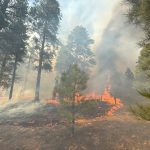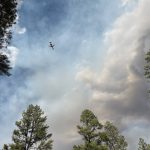
Guest Column | Add a Native veteran to Vietnam Memorial
By Floyd Dawson
Ya’at’eeh, my name is Floyd Dawson. My clans are Zuni Edgewater, born for Many Goats. My maternal grandfather is Deer Water and my paternal grandfather is Bitter Water.
I am from Tonalea, Arizona, 26 miles northeast of Tuba City, on State Route 160. If you leave Flagstaff and go 103 miles you will find yourself deep in the heart of the Navajo Nation at a small community called Tonalea, with a population of 2,512 and an elevation of 5,660.
I initiated the memorial statue to be erected at the Vietnam Veteran Memorial in Washington, D.C. I made my voice heard in the halls of Congress and the White House. This is a never-ending process.
I am not a veteran, an elected leader, nor a hero. I only finished high school. I do not have a college degree and I never received a preschool diploma either.
I thought to myself, I am nobody, and who is going to listen to me if I try to voice my concern, but I come from a family of Vietnam veterans.
When I was 16 years old, I lost my oldest brother, Cpl. Jerry Lorenzo Daw, in the Vietnam War on June 8, 1967. He left as a young man, eager and brave, with dreams of glory as an infantryman in the 101st Airborne Division.
My dream of erecting a statue in the nation’s capital took a giant step forward when former President William Clinton signed Public Law 103-384, the “National Native American Veterans’ Memorial Act of 1994.” My prayers and wishes were answered.
I have visited the Vietnam Veterans Memorial site four times in Washington. A place where family, friends, comrades, and the American Gold Star mothers come together to remember the 58,132 dead and missing whose names are engraved there on the Black Wall. There are names of Native American veterans on the Black Wall at the memorial.
July, 1988, I visited the Vietnam Veterans Memorial Black Wall in Washington. I saw a life-size eight-foot bronze statue of three infantrymen representing Hispanic, Anglo and Black. Where is the Native American? They left out Native American veterans.
Conducting a one-man campaign to add a fourth figure to the sculpture, I requested of the U.S. government to seriously consider placing a statue of a Native American veteran next to the statue of the other three ethnicities at the Vietnam Veterans Memorial.
I expressed this idea to the officials of the Friends of the Vietnam Veterans Memorial in Washington. Tonalea Chapter also supported this with a chapter resolution. My cousin, Lindberg Lee, helped me circulate petitions and we collected 12,700 signatures within five months.
In summary, requesting the Congress and the president of the United States to erect a memorial statue honoring Native American veterans.
Oct. 8, 1990, resolution of the Tonalea Chapter was passed with a vote of 46 in favor and 0 opposed. Oct. 25, 1990, resolution of the Navajo Nation Council also passed a vote of 66 in favor and 0 opposed.
I traveled to Santa Fe three times to lobby and state of Arizona with my own expenses and my own transportation.
Feb. 7, 1991, the Legislature of Arizona passed a Senate concurrent resolution, introduced by State Sen. James Henderson Jr., from Ganado. The House of Representatives concurred.
April 4, 1991, the Legislature of New Mexico passed a Senate joint memorial, introduced by State Sen. John Pinto. The House of Representatives concurred.
Feb. 3, 1993, Congress Senate Bill No. 293, was passed, introduced by John McCain from Arizona.
May 17, 1993, Congress House Bill No. 2135 was passed, introduced by U.S. Rep. Craig Thomas from Wyoming.
Oct. 22, 1994, the president of the United States, William Clinton, signed the bill, the “National Native American Veterans Memorial Act.”
If my brother was not killed in Vietnam, I wouldn’t be doing this or saying this for all Native American veterans of the United States. I would have been out in the streets asking for quarters to buy another pint of wine, or marijuana and other drugs.
This is an example of how we are being treated by the U.S. government. Alcohol and drugs are being used to eliminate our people and the judicial system wonders why our people are being sent to prison today.
You can see why we Native Americans feel that we deserve recognition by placing another statue at the Vietnam Veterans Memorial.
The memorial is the most visited outdoor memorial in the nation’s capital and it is sad that a statue of the Native American veterans was not placed next to the statue of the men.
I have nothing against the other races exemplified in the sculptures that are at the Vietnam Veterans Memorial. It is just that there is one person missing and I am proud of them, what they stand for, and what they did for us.
I feel, as an Indigenous people of the United States, we have the right to be heard and represented as veterans. Most times, we Native Americans do not always get what we want. What we’re asking for is very little.
When a Native American does something spectacular we are not applauded nor given our due credit. You don’t see our names across the media. However, when a Native American does something wrong then that particular incident is given biased, overwhelming media coverage.
We are a proud people. We just want our due respect. I have always been a voice for all Native American veterans, locally, statewide, and federally. On behalf of our service men and women, thank you, and may God bless you.
Floyd Dawson, from Tonalea, Ariz., is founder of the National Native American Veterans Memorial.








 Highway 264,
Highway 264, I-40, WB @ Winslow
I-40, WB @ Winslow